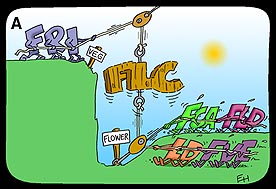
This page was produced as part of an undergraduate seminar at Davidson College.
Flowering Time Control: 2 Key Factors
Flowering Control: What you need to know
Though many factors control the commitment of a plant to flower, there are only two we need to understand to comprehend the discovery of “super cabbage.” The two aforementioned factors are vernalization and the autonomous gene pathway.
Vernalization:
Vernalization is a process by which a plant begins to flower after long-term exposure to low temperatures. Normally, this process is used in plants to allow commitment to flowering during the favorable growing period of spring. It is the same with Arabidopsis, they vegetate and increase leaf size over the winter and flower during the spring (Simpson and Dean, 2002). The vernalization process in Arabidopsis is regulated by FRI, which encodes a coiled protein that functions in the plant to increase production of FLC (Flowering Locus C) mRNA (Simpson and Dean, 2002). FLC encodes a MADS-Box transcription factor that, in turn, has the effect of delaying flowering (Simpson and Dean, 2002). Regardless of the mechanism of vernalization, the influence of this process strongly overpowers the Autonomous Gene Pathway (Amasino, 2003), discussed in the next section. For help in understanding this further, follow the cartoon below.

Cartoon Image of Vernalization as described above (Amasino, 2003) *Permission Pending*
1) After exposure to cold temperatures, FRI increases expression of FLC. (Simpson and Dean, 2002)
2) Increased FLC causes the plant to delay reproduction and not flower during such unfavorable environmental conditions. (Simpson and Dean, 2002)
3) The control of FRI over the expression of FLC overrides the influence of the Autonomous Gene Pathway, the importance of this will be made apparent. (Amasino, 2003)
Autonomous Pathway:
The autonomous flowering pathway in Arabidopsis consists of six genes: FCA, FY, FPA, LD, FLD, and most importantly FVE (due to its importance in creating "Super Cabbage") (Simpson and Dean, 2002). This system, which functions independently of environmental factors, could possibly be related to the developmental age of the plant (Simpson and Dean, 2002). The exact mechanism by which the autonomous pathway in Arabidopsis and other plants functions is largely unknown but is under intense investigation. For our purposes in the understanding of "Super Cabbage," we will pay closer attention to FVE. FVE codes a retinoblastoma-associated protein with homology to mammalian histone deacetylase (Ausin et al, 2004). The Ausin research group found that when FVE became absent from the pathway through the use of a null mutation (a mutation that disables the autonomous pathway), more FLC was enriched in acetylated histones (Ausin et al., 2004). If FVE works to deacetylate the histones of Arabidopsis DNA then, in its absence, acetyl groups accumulate and FLC levels are lowered as a result. Knowing the molecular effect that FVE has on FLC aids in the understanding of much of the underlying theory regarding "Super Cabbage."
The Big Picture:
It is these two factors, which control the flowering commitment in Arabidopsis, that scientists keep in mind to theorize the creation of a new form of GMO. In the next section, we will explore what scientists in Korea have discovered that could be used to create a genetically modified form of cabbage.
Return to the Genetically Modified Organisms Seminar Homepage
Return to the Biology Department at Davidson College
Return to the Davidson College Homepage
Questions? Comments? Suggestions? Email Matt Talbert ('05) by clicking here.